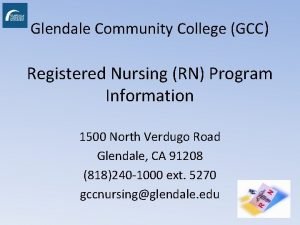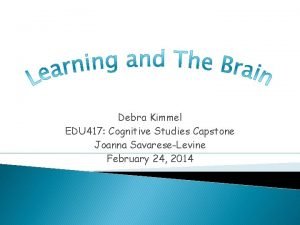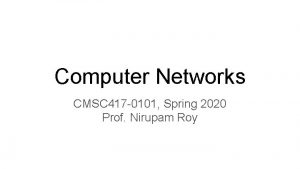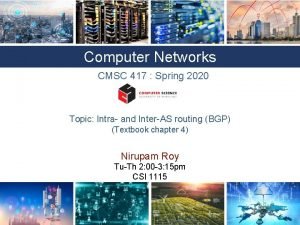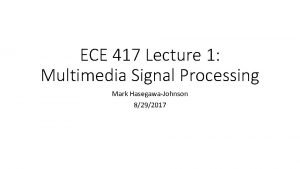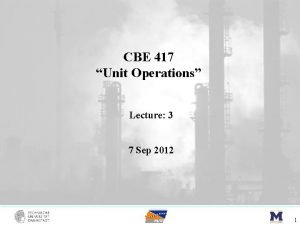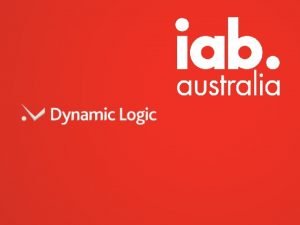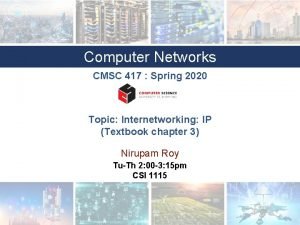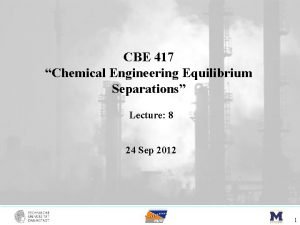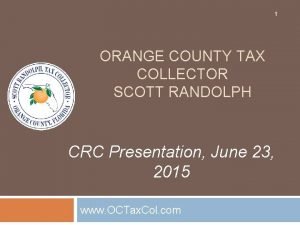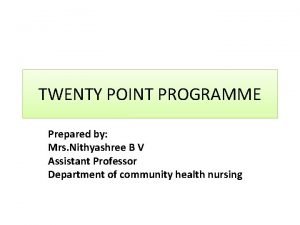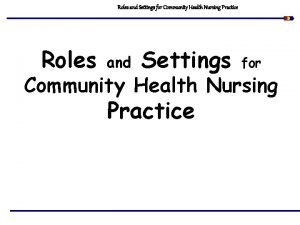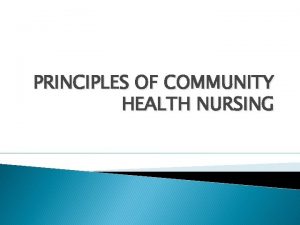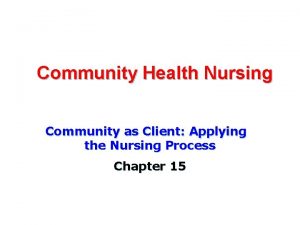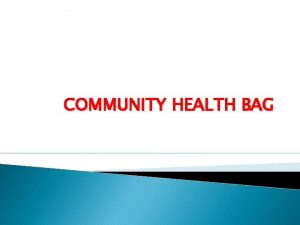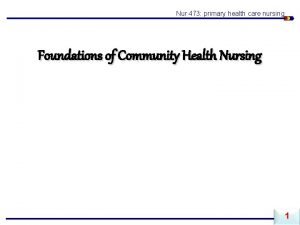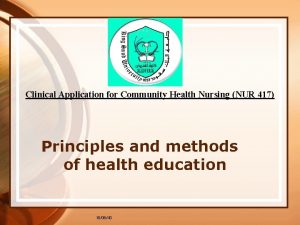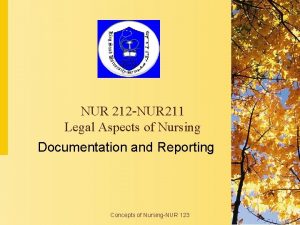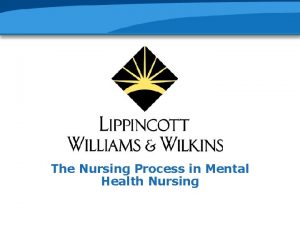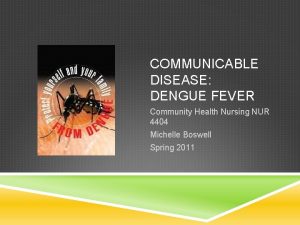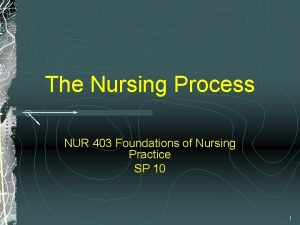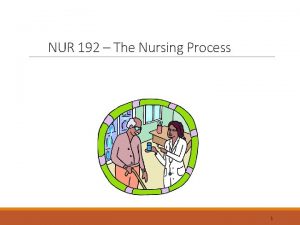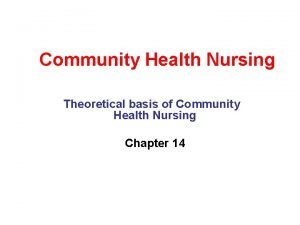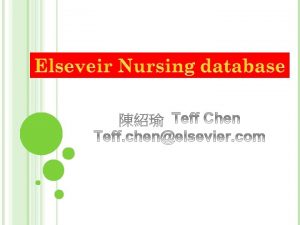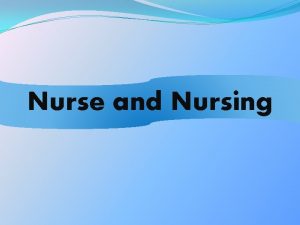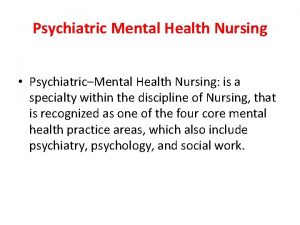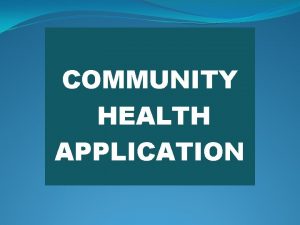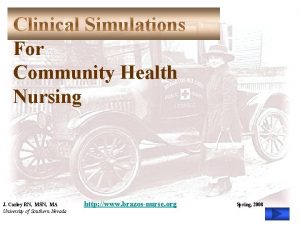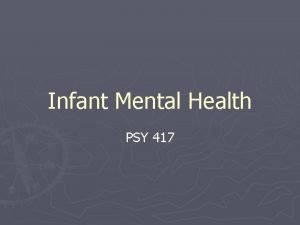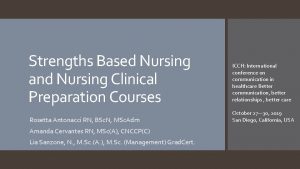Clinical Application of Community Health Nursing NUR 417

























- Slides: 25

Clinical Application of Community Health Nursing (NUR 417) Family assessment 1

After completion the lecture the students enable to: q. Define the family q. Describe the roles and functions of the family q. Describe the different types of families q. Describe the Characteristics of healthy family q. Discuss Family Health Practice Guidelines q. Discuss family health assessment q. Data Collection Categories q. Assessment Methods q. Guideline for family health assessment 2

Introduction Ø Working in a community setting generally involves working with families. Ø CHN (Community Health Nursing) must there for understand the interactions and dynamics of families so that they can provide appropriate family assessment , planning, intervention and evaluation Ø Thus an understanding of family dynamics and the context of the community assists the nurse in planning care. 3

Definition Ø Family: is two or more persons related by birth, marriage, or adoption who reside together in a household. Ø Family is a structural unit composed of a man and women who are married and have children Ø Legally married or traditionally married. It’s the only form accepted culturally in our regions 4

Characteristics of the family q Every family is a social system q Every family has a it’s own cultural values and rules q It is the first social group to which the individual is exposed q Every family has a structure q Every family have certain basic function q Every family moves through stages in its life cycle 5

Types of family structure q Nuclear family a family group consisting of a pair of adults and their children. q Extended family a family that extends beyond the immediate family, consisting of grandparents, aunts, uncles, and cousins all living nearby or in the same household. q Commune family an intentional community of people living together, sharing common interests, property, possessions, resources, and, in some communes, work and income. 6

Types of family structure q Family of procreation The family that is formed when a couple have their first child. q blended family a family here one parent has children that are not genetically related to the other parent. Either one or both parents may have children from a previous relationship q single parent family is a parent, not living with a spouse or partner, who has most of the day-to-day responsibilities in raising the child or children.

Function of the family a. Affection, love, care, an emotional support b. Security c. Identity d. Affiliation e. Socialization f. Control g. A sense of belonging and of history and place h. Family rituals for rejoicing and grieving i. Systems for earning money , supporting partners and children j. Sharing of labor, chores required to keep the family running 8

Health tasks of the family q. Recognizing interruptions of health or development. q. Seeking health care q. Managing Health and non- health crises q. Providing nursing care to the sick, disabled and dependent member of the family. q. Maintaining a home environment conductive to good health and personal development. q. Maintaining a reciprocal relationship with the community and health and institutions 9

Importance of family health 1. Family as a unit of services 2. Effect of the family health on individual health 3. Effect of family on community health 10

Conceptual frameworks q A conceptual framework is a set of concepts integrated into meaningful explanation that helps one interpret human behavior or situations. q. Three frameworks that are particularly useful in community health nursing are presented here: 1. Interactional frameworks 2. Structural-functional frameworks 3. Developmental frameworks 11

Interactional framework 1 - Interactional Framework: Describes the family as a unit of interacting personalities and emphasizes communication, roles, conflict, coping patterns, and decision-making processes 12

Interactional framework 2 - Structural-functional Framework: Describes the family as a social system relating to other social systems in the external environment, such as school, work, and the health care system. 3 - Developmental Frameworks: Studies families from a life-cycle perspective by examining members’ changing roles and tasks in each progressive life-cycle stage 13

family developmental tasks 1. Beginning family Ø Establishing a mutually satisfying marriage Ø Planning to have or not have children 2. Childbearing family Ø Having and adjusting to infant Ø Support needs of all three members 3. Family with pre- school children Ø Adapting to needs of pre-school children to stimulate growth and development 14

4. Family with school age children Ø Adjusting to the activity of growing children Ø Promoting joint decision making between children and parents. Ø Encouraging and supporting children’s educational achievements 5. Family with teenagers and young adults Ø Maintaining open communication among members. Ø Supporting ethical and moral values within the family. Ø Balancing freedom with responsibility of teenagers. 15

6. Post- parental family Ø Preparing for retirement Ø Maintaining ties with younger and older generations. 7. Aging family Ø Adjusting to retirement Ø Adjusting to loss of spouse 16

The family as client: assessment and diagnosis Guidelines for family health assessment 1 -Focus on the family as a total unit 2 -Ask goal-directed questions 3 -Collect data over time 4 -Combine quantitative and qualitative data 5 -Exercise professional judgment 17

Family Health Practice Guidelines - Planning and intervention for families must be in partnership with family members, not imposed from by CHN - Planning and intervention for families by CHN must used the three level of prevention - Work with the family collectively - Start where the family is - Fit nursing intervention to the family stage of development - Recognize the validity of family structural variation - Emphasize family strength 18

Assessment methods Ø Many different methods are used to assess families. Ø These methods serve to generate information about selected aspects of family structure and function; the methods must match the purpose for assessment. 19

Assessment methods 1. Ecomap Is diagram of the connection between a family and the other system in its ecological environment or its A picture of the family’s patterns. Nurses can use an ecomap to identify: a. Family resources that are present b. Family needs c. Conflicts d. Connections that are present or absent e. The balance or lack of balance between a family's needs and the resources available to the family 20

21

Assessment methods 2. Genogram A graphic picture of family history, usually used over three or more generation. The genogram maps such information as/; a. Relationships among family members b. Important life events c. Place of residence d. Characteristics such as race, culture and religious affiliations 22

23

Assessment methods 3. Social Network Support Map or Grid Gives details about the quality and quantity of social connections. Strengths within the system can be elaborated with words, or numbers, or a combination of these. The nurse uses this tool to help the family understand its sources of support and relationships and to form a basis for nursing care planning and intervention. 24

Assessment methods 4. Family Health Tree a record of diseases that occur in a family. It can be used to track: a. Diseases that have genetic bases b. Environmental diseases c. Mental health disorders 25
 Nursing program in glendale
Nursing program in glendale Southwest airlines route map
Southwest airlines route map Joanna savarese
Joanna savarese Cmsc417
Cmsc417 Cmsc417
Cmsc417 Department of transportation
Department of transportation Ece 417
Ece 417 Cmsc 417
Cmsc 417 Cbe 417
Cbe 417 Campaign_id:417
Campaign_id:417 Ece 417
Ece 417 Internetwork
Internetwork Stripping rectifying section
Stripping rectifying section Dmv appointments
Dmv appointments 20 point programme introduction
20 point programme introduction Example of community health nursing diagnosis statement
Example of community health nursing diagnosis statement What is a nursing diagnosis statement
What is a nursing diagnosis statement Role of the community health nurse
Role of the community health nurse Community health nursing principles
Community health nursing principles Ongoing planning in nursing
Ongoing planning in nursing Nursing care plan hallucinations
Nursing care plan hallucinations Example of community health nursing diagnosis statement
Example of community health nursing diagnosis statement Community bag definition
Community bag definition Historical development of community health
Historical development of community health Home visit assignment
Home visit assignment Community health definition
Community health definition
